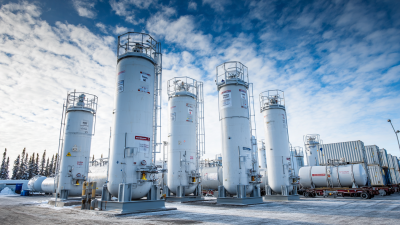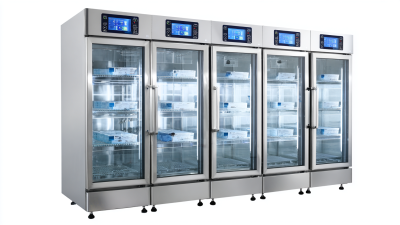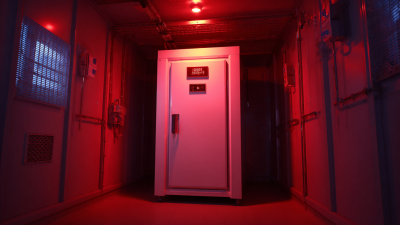
-
Home
-
About us
-
Products
-
Solutions
-
News
-
Blog
-
Contact us
Leave Your Message

In the ever-evolving realm of medical technology, the introduction of advanced Cryogenic Containers is set to revolutionize the way we store vital biological samples and pharmaceutical products. As healthcare professionals and researchers strive for higher efficiency and reliability, these innovative containers have emerged as the cornerstone of modern storage solutions. Dr. Sarah Thompson, a renowned expert in cryobiology, notes, "The future of medical storage lies in the integration of cryogenic technology, which not only preserves the integrity of samples but also enhances accessibility and usability in critical applications."
The latest innovations in Cryogenic Containers are marked by significant advancements in materials and design, aimed at optimizing temperature control and energy efficiency. These state-of-the-art containers ensure that sensitive biological materials remain preserved at ultra-low temperatures, providing a safe and stable environment for long-term storage. The ability to maintain such conditions is crucial for research and therapeutic processes, particularly in fields like regenerative medicine and transplantology.
As the demand for high-quality storage solutions continues to grow, the development of next-generation Cryogenic Containers is not just a trend but a necessity. With an increasing focus on patient care and the ethical handling of biological materials, the industry is poised for transformative changes that will benefit laboratories and healthcare facilities worldwide. Embracing these innovations will ultimately lead to enhanced outcomes in medical research and improved patient safety.

The surge in demand for cryogenic containers in medical applications is largely driven by the rapid advancements in biotechnology and cell therapy. These innovative storage solutions are critical for preserving biological samples such as stem cells, tissues, and other vital components at ultra-low temperatures. With the increasing reliance on personalized medicine, the healthcare industry is now prioritizing optimal storage methods to ensure sample integrity and viability for future treatments.
As medical professionals seek efficient and reliable storage options, it's essential to choose cryogenic containers that meet specific requirements. **Tip:** When selecting a cryogenic container, consider its insulation capabilities and durability to prevent temperature fluctuations that could compromise sensitive materials. Additionally, ensure that the container is easy to handle and transport, especially in laboratory settings where mobility is crucial.
Innovations in cryogenic technology are also focusing on enhancing user experience and safety. New designs incorporate advanced monitoring systems to track temperature variations, ensuring that critical samples remain frozen during emergencies or system failures. **Tip:** Regularly check the functionality of monitoring systems and alarms to maintain sample safety. With these cutting-edge solutions, cryogenic containers are poised to play a pivotal role in the evolution of medical practices.
| Feature | Description | Applications | Market Demand (%) |
|---|---|---|---|
| Temperature Control | Maintains ultra-low temperatures for viable biological samples. | Biobanking, Research, Transplants | 75% |
| Cryogenic Insulation | Advanced insulation technology to minimize heat transfer. | Pharmaceuticals, Blood storage | 60% |
| Portability | Lightweight and ergonomic design for easy transport. | Field Research, Medical Emergencies | 50% |
| Safety Features | Integrated safety alarms and monitoring systems. | Patient Care, Laboratory Use | 80% |
| Smart Technology | IoT-enabled for real-time monitoring and alerts. | Telemedicine, Research Facilities | 65% |
Recent advancements in insulation technologies have significantly improved the efficiency of cryogenic containers used in medical applications. These state-of-the-art insulation materials reduce thermal conductivity, allowing the containers to maintain extremely low temperatures for extended periods. Innovations such as aerogel and advanced composite materials are at the forefront, providing not only superior insulation but also lightweight properties that enhance portability and ease of use in clinical settings.
Moreover, the development of vacuum insulation techniques has played a crucial role in optimizing cryogenic storage solutions. By creating a vacuum layer, these containers minimize heat transfer, thereby preserving the integrity of sensitive biological materials such as stem cells and organ tissues. With these enhancements, medical professionals can ensure that critical specimens are stored under optimal conditions, improving reliability and safety in medical treatment and research. As these technologies evolve, the potential for extending cryogenic storage capabilities to various medical applications continues to grow, marking a transformative phase in healthcare and research methodologies.
The landscape of cryogenic storage solutions has transformed dramatically with the advent of advanced cryogenic containers, setting them apart from traditional models.
Conventional cryogenic containers primarily utilize static insulation techniques, relying on materials like foam or fiberglass. While effective for short-term storage, these methods tend to lead to significant heat transfer over time, resulting in the loss of precious samples and increased operational costs. Their design limits mobility and scalability, making them less ideal for dynamic medical environments such as hospitals or research facilities.
In contrast, advanced cryogenic containers introduce innovative features that enhance both efficiency and usability. Many of these next-generation models implement dynamic insulation technologies, such as vacuum layers and advanced materials, to minimize heat transfer and extend the viability of stored biological samples. Additionally, features like smart monitoring systems and automated dispensing mechanisms improve user interaction and sample integrity.
The integration of portability and enhanced storage capabilities in advanced containers not only reduces the risk of temperature fluctuations but also meets the growing demands of modern medical practices, particularly in fields requiring precise and reliable preservation of sensitive materials.
The advancement of cryogenic storage solutions for medical use has significantly transformed how we preserve essential biological materials, such as blood, organs, and stem cells. However, with these innovations comes the critical necessity to adhere to strict regulatory and safety standards. Agencies like the FDA and ISO have established comprehensive guidelines to ensure that cryogenic containers not only maintain optimal temperatures but also guarantee the integrity and safety of their contents. These regulations are designed to prevent contamination and ensure precise monitoring during storage and transport.
Tip: Always verify that your cryogenic storage equipment complies with local and international standards. Regular audits and validations can help safeguard your facility against compliance-related issues.
In addition to regulatory compliance, safety measures play a vital role in the handling of cryogenic containers. Proper labeling, emergency response protocols, and staff training are essential components of a robust safety program. Ensuring that personnel are well-informed about the potential hazards associated with cryogenic materials can mitigate risks significantly.
Tip: Consider implementing regular training sessions for staff that cover emergency protocols and the specific handling of cryogenic substances to enhance safety awareness.
As the medical field continues to advance, the importance of cryogenic systems is becoming increasingly prominent. The global cryogenic market is expected to reach USD 24.52 billion by 2027, growing at a CAGR of 9.2% from 2020. This growth is driven by a surge in biobanking and the need for advanced storage solutions for blood plasma, stem cells, and tissue samples. The latest innovations in cryogenic containers, including composite materials and smart monitoring technologies, enhance both the safety and performance of these storage systems.
Tips: Always ensure that your cryogenic containers are compliant with safety regulations and include temperature monitoring systems. Utilizing innovative designs can help reduce liquid nitrogen consumption and extend the lifespan of stored biological materials.
Future trends indicate a shift toward automated cryogenic systems that integrate IoT capabilities, allowing healthcare facilities to monitor and manage their storage environments in real time. This evolution aligns with the growing emphasis on efficiency and data-driven decision-making in healthcare. As we look ahead, the synergy between cryogenic technology and digital health will likely play a pivotal role in optimizing patient care and preserving vital biological samples for future research.
Tips: Consider incorporating automated alerts for temperature fluctuations to minimize the risk of sample loss. Regularly scheduled maintenance of cryogenic equipment will also ensure operational efficiency and reliability.





